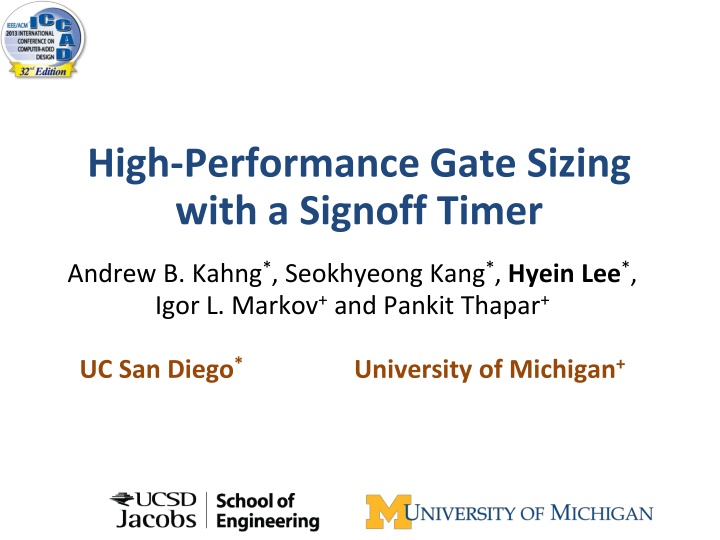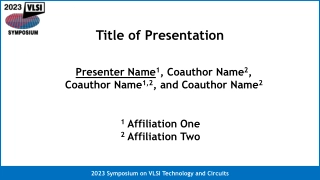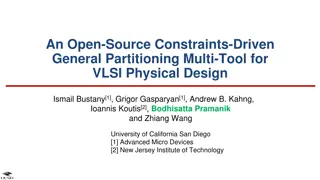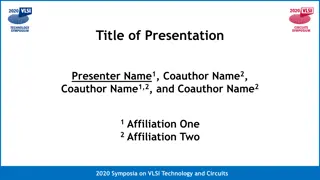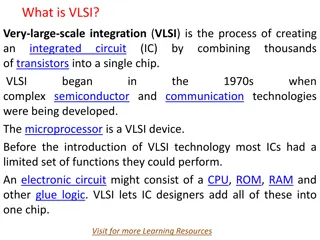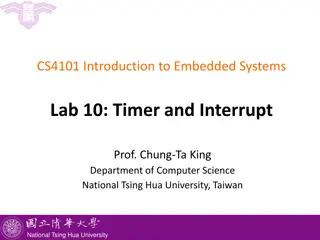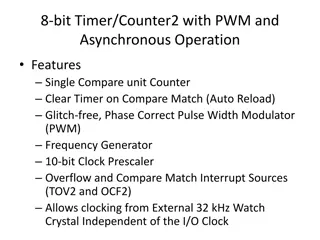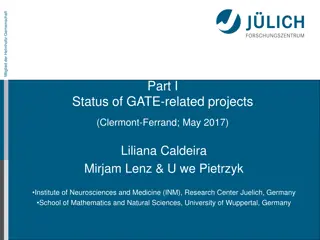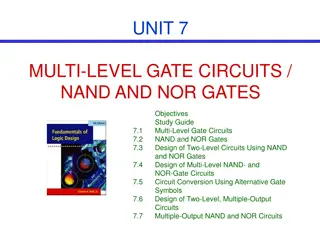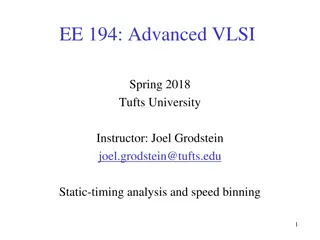High-Performance Gate Sizing with Signoff Timer: VLSI Design Challenges
This study delves into the intricate realm of gate sizing in VLSI design, focusing on optimizing power and delay through effective approaches and addressing challenges such as interconnect delay, inaccurate internal timers, and critical paths. Previous gate sizing techniques are evaluated, and a metaheuristic optimization method is proposed. The work extends Trident 1.0 and emphasizes the importance of interconnect delay calculation for realistic solutions.
Download Presentation

Please find below an Image/Link to download the presentation.
The content on the website is provided AS IS for your information and personal use only. It may not be sold, licensed, or shared on other websites without obtaining consent from the author.If you encounter any issues during the download, it is possible that the publisher has removed the file from their server.
You are allowed to download the files provided on this website for personal or commercial use, subject to the condition that they are used lawfully. All files are the property of their respective owners.
The content on the website is provided AS IS for your information and personal use only. It may not be sold, licensed, or shared on other websites without obtaining consent from the author.
E N D
Presentation Transcript
High-Performance Gate Sizing with a Signoff Timer Andrew B. Kahng*, Seokhyeong Kang*, Hyein Lee*, Igor L. Markov+and Pankit Thapar+ UC San Diego* University of Michigan+ File:University of Michigan wordmark.svg
Outline Gate Sizing in VLSI Design Previous Work Challenges in Gate Sizing High-Performance Gate Sizing with a Signoff Timer Overall Flow Experimental Results Conclusions and Future Work 2
Gate Sizing in VLSI Design Effective approach to power, delay optimization Objective: minimize power Satisfy constraints: slack, slew, max load capacitance, Tunable cell parameters: gate width, Vth, gate length Select a proper library cell for each gate gate-width (drive-strength) INVX2 INVX4 INVX8 INVX16 LVT multi-Vth HVT NVT Lgate-bias L=65nm L=60nm L=55nm higher (leakage) power higher speed lower (leakage) power lower speed 3
Previous Gate Sizing Techniques Common heuristics/algorithms Convex optimization Linear programming Continuous gate sizing Lagrangian relaxation Discrete gate sizing Sensitivity-based sizing Dynamic programming Limitations Continuous gate sizing : industrial cell libraries have discrete gate sizes, and rounding solutions may be suboptimal Discrete gate sizing : NP-hard problem scalability issue Do not account for realistic delay models and constraints (capacitance, slew) 4
Previous Work Our work extends Trident 1.0 [Hu et al. Proc. ICCAD 2012] Produced strongest results on ISPD 2012 benchmarks as of ICCAD 2012 Metaheuristic optimization with importance sampling and sensitivity-guided search Limitation: no interconnect delay calculation Unrealistic assumption 5
Outline Gate Sizing in VLSI Design Previous Work Challenges in Gate Sizing Issue 1: Interconnect delay Issue 2: Inaccurate internal timer Issue 3: Critical paths High-Performance Gate Sizing with a Signoff Timer Overall Flow Experimental Results Conclusions and Future Work 6
Challenges in Gate Sizing Sizing problem seen at all phases of RTL-to-GDS flow Becomes more challenging at later design stages Timing constraints are strict Gate sizing can result in large change in interconnect delay Gate Level Netlist Placement Placed Netlist Gate Sizing Route Routed Netlist Our Problem Interconnects Challenging Realistic nature in the ISPD 2013 Contest benchmarks Routed netlists including interconnect Use an industry signoff timer Many near-critical paths in benchmarks 7
Issue 1: Interconnect Delay/Slew Gate sizing affects up/downstream gates/nets delay Slew change S1 FI1 T FO1 FO2 FI2 S2 Pin capacitance change Slew degradation from interconnects makes delay worse Impact of gate sizing becomes larger with interconnects Careful gate sizing is needed 8
Issue 2: Inaccurate Internal Timer Internal timer is not perfectly matched with signoff timer Calibration to signoff timer can be used Still, the error increases with netlist changes Error accumulation with netlist change Error (internal signoff) # cell change Netlist change Periodic timing calibration to a signoff timer is needed to avoid divergence 9
Issue 3: Critical Paths Many near-critical paths in the given benchmarks Challenging to obtain a timing feasible solution cordic_fast (hard) netcard_fast (easy) * From ISPD 2013 Discrete Gate Sizing Contest Presentation Dedicated critical path optimization is needed 10
Outline Gate Sizing in VLSI Design Previous Work Challenges in Gate Sizing High-Performance Gate Sizing with a Signoff Timer Internal Timer with Interconnect Timing Models Calibration to a Signoff Timer Critical Path Optimization Sensitivity Functions Overall Flow Experimental Results Conclusions and Future Works 11
1. Internal Timer with Interconnect Timing Models Internal timer is essential to estimate delay changes during gate sizing Requirements for an internal timer Able to calculate interconnect delay/slew Fast enough for move-based optimization Accurate enough to track signoff timer Our approach: use best-performing models for interconnect delay/slew from previous work 12
Interconnect Delay/Slew : Pre-Existing Models Early optimization does not require accuracy fast interconnect models We use pre-existing fast models Slew models Delay models Elmore delay D2M DM1, DM2 PERI S2M Effective Cap. models D2M: Alpert et al. ISPD 2000 DM1,DM2: Kahng et al. TCAD 1997 PERI: Kashyap et al. TAU 2002 S2M: Agarwal et al. TCAD 2004 McCormick: Ph.D. Thesis 1989 McCormick Total Cap. 13
Interconnect Delay/Slew : Model Selection Model selection criterion: endpoint slack error between the signoff timer and our estimation Endpoint slack error distribution Normalized mean/std. of endpoint slack error x-axis: slack error (ps), y-axis: % of #paths 6 Mean StDev (EM, PERI) (D2M,PERI) 5 4 3 2 1 (DM1,PERI) (DM2,PERI) 0 The (D2M, PERI) model combination has the smallest mean and standard deviation 14
2. Calibration to a Signoff Timer Challenges in matching the results of the signoff timer Timing divergence with netlist changes The divergence can be compensated with Offset-based slack calibration [Moon et al., U.S. Patent 7,823,098] Periodic calibration to a signoff timer to avoid large divergence How often should we calibrate? offset = signoff timer internal timer Internal Timer Signoff Timer Request timing information 15
Calibration Frequency vs. Error Impact of calibration frequency on average slack error during the optimization Calibration frequency (X%): calibration is performed whenever X% of cells have been changed (avg.) slack error over the signoff timer 5% threshold <10ps slack errors % of changed cell during leakage optimization 16
Efficient Signoff-Timer Interface Tcl socket interface to communicate with signoff timer Fast and efficient for frequent query of timing info Sizer Signoff timer Open socket Launch signoff timer Load design Cell swap list Cell sizing Update cell size Timing results Timing calibration incremental STA 17
3. Critical Path Optimization For a design having many near-critical paths, dedicated optimization is needed Critical path optimization: optimize cells on the timing critical paths (critical cells) to reduce WNS* Method 1 : Downsizing fanouts Method 2 : Peephole optimization * WNS: Worst Negative Slack 18
Critical Path Optimization: Downsizing Fanouts Downsizing fanouts of critical cells Improve delay of the target cell by reducing load Downsizing to reduce input cap. Speed up the target cell with reduced output load Speed Target critical cell Critical cells Fanout cells Select the target critical cell with highest sensitivity score small gate with large fanout loads ?????? =????(?) ????(?) *c : critical cell 19
Critical Path Optimization: Peephole Optimization Exhaustive search for the best solutions of k critical cells All possible combinations are listed in order of Gray code minimize the overhead of incremental STA (iSTA) current window Critical path N(# trial) = {#size option}^{k} Enumerate all possible combination w/ Gray code trial1 iSTA pick the best move trial2 ... trialN * STA: Static Timing Analysis 20
4. Sensitivity Function Sensitivity function (SF): guide to identify the most promising cells to size SF for timing recovery impact of sizing on total negative slack (TNS) relative to leakage penalty ?????, ???????_?????: slack, leakage power #??? ?: the number of paths passing through the cell ?: leakage exponent parameter ????? #????? ???????_?????? change after cell sizing ?? = SF for leakage reduction impact of sizing on leakage reduction relative to timing penalty SF2 SF3 SF4 SF5 ??????? ????? ??? = ??????? ???????/( ????? #??? ?) delay delay ??????? ?????/#??? ? ??????? ?????/( ????? #??? ?) 21
Outline Gate Sizing in VLSI Design Previous Work Challenges in Gate Sizing High-Performance Gate Sizing with a Signoff Timer Overall Flow Global Timing Recovery Power Reduction with Feasible Timing Experimental Results Conclusions and Future Work 22
Overall Optimization Flow Overall flow: Timing Recovery (TR) + Power Reduction with Feasible Timing (PRFT) Routed Netlist, SPEF Set to minimum size TR w/o signoff timer Find the best parameters for SF Timing Recovery TR w/ signoff timer Find timing feasible solution Leakage reduction with Sensitivity-Guided Gate Sizing PRFT SGGS Power Reduction w/ Feasible Timing PRFT Kick-Move Further leakage reduction Sizing Solution *SF : Sensitivity Function 23
Timing Recovery: Overall Procedure Objective: find timing feasible solution Global Timing Recovery (GTR) : core procedure in this stage Phase 1: multi-threaded coarse search to find the best ( , ) Phase 2: feasible solution search with accurate timing info <GTR procedure> Two parameters in GTR : leakage exponent in SF : commit ratio (% of upsizing) STA Calculate sensitivity ( ) ????? #????? ???????_?????? ?? = Upsize % of promising cells No Timing met? 24
Timing Recovery: Overall Procedure Objective: find timing feasible solution Global Timing Recovery (GTR) : core procedure in this stage Phase 1: multi-threaded coarse search to find the best ( , ) Phase 2: feasible solution search with accurate timing info GTR( , ) w/o signoff timer Guardband (GB) <GTR procedure> Multi-threaded STA No Feasible? Feasible? Calculate sensitivity ( ) Best parameter ( , ) Yes GTR( , ) w/ signoff timer Upsize % of promising cells No Local No Feasible? Timing met? Timing Recovery Yes Timing feasible solution 25
PRFT: Sensitivity-Guided Gate Sizing Objective: reduce leakage of timing feasible solution Sensitivity-guided gate sizing (SGGS) Various sensitivity functions are tried Repeat SGGS with kick-move SGGS procedure SGGS(SFi) STA Timing recovery Calculate sensitivity (SFi) No Downsize a promising cell C Feasible? Revert the sizing Yes Next Sensitivity Function (SFi) Kick-Move slack (C ) < 0 Yes No Best solution 26
Outline Gate Sizing in VLSI Design Previous Work Challenges in Gate Sizing High-Performance Gate Sizing with a Signoff Timer Overall Flow Experimental Results Conclusions and Future Work 27
ISPD 2013 Gate Sizing Contest ISPD 2013 Benchmarks : realistic circuits and constraints Netilst (Verilog), parasitics (SPEF), timing constraint (SDC) Max slew/load constraint Library: 11 logic functions, 30 cell types (three multi-Vth and ten different sizes) 330 cells Leakage power of violation-free solutions are compared Final timing evaluation with a commercial signoff tool 28
Experimental Results: Power and Runtime Result Power and runtime comparison vs. contest best result 9% leakage, ~3X runtime improvement on average in fast mode 7% leakage degradation in normal mode (runtime comparison is not available in normal mode) Normalized leakage power and runtime in normal/fast mode 60% 1000% Best leak in fast Best leak in normal Runtime of best leak in fast 800% 40% 600% 400% 20% Leakage Runtime 200% 0% 0% -200% -20% -400% -600% -40% -800% -60% -1000% Source: http://www.ispd.cc/contests/13/ISPD_2013_Contest_Final.pdf 29
Experimental Results: Runtime Breakdown Signoff timer runtime contribution : 20~60% Overall runtime breakdown Signoff timer runtime contribution 30
Experimental Results: Optimization Trajectories Normalized TNS* and leakage power change over timing recovery (TR) iterations After timing calibration, TNS increases due to discrepancy between internal timer and signoff timer * TNS: Total Negative Slack 1.2 2.6 TNS Leakage 2.4 1.0 Normalized Leakage Normalized TNS 2.2 0.8 2.0 0.6 1.8 After timing calibration 1.6 0.4 1.4 0.2 1.2 0.0 1.0 0 5 10 15 20 25 30 # TR iteration TR without signoff timer TR with signoff timer 31
Experimental Results: Impact of Timing Inaccuracy Inaccurate timing with the internal timer at optimization leakage increase at final signoff stage Compensate inaccuracy : calibration, margin (guardband) Periodic calibration with 5% calibration frequency minimum leakage without timing violation Result of pci_b32_fast calibration (5%) no calibration GB=10ps init calibration GB=5ps -450 112% calibration (5%) init calibration no calibration GB=5ps GB=10ps -400 Normalized Leakage (%) -350 109% -300 TNS (ps) -250 106% -200 103% -150 -100 100% -50 0 97% Optimization Final signoff Optimization Final signoff 32
Conclusions and Future Work Trident2.0: high-performance gate sizing Fast interconnect models with reasonable accuracy for an efficient internal timer Calibration to a signoff timer with an interface to improve timing accuracy Dedicated critical path optimization with heuristics ISPD 2013 gate sizing contest Trident 2.0 took 2nd and 1st places in two contest categories, respectively Future work See if Lagrangian relaxation helps Additional industry benchmarks 33
